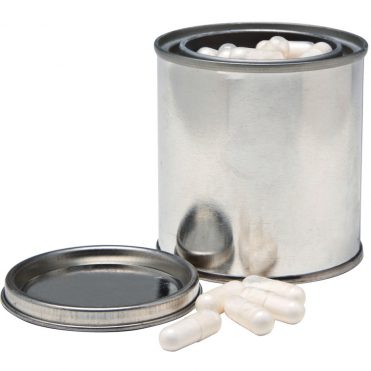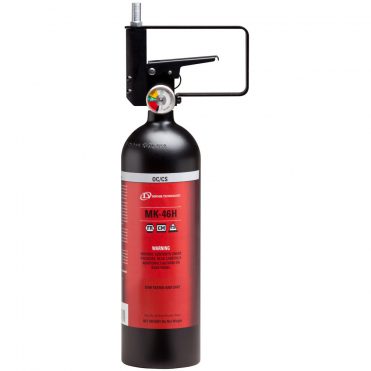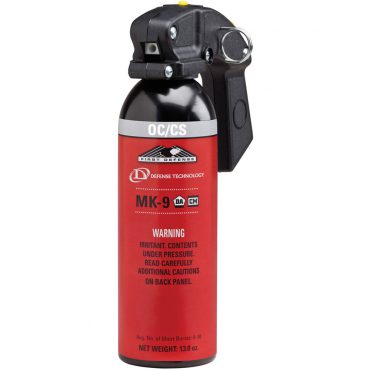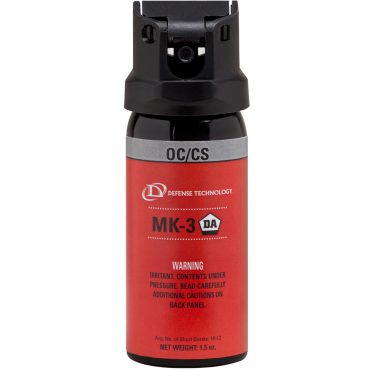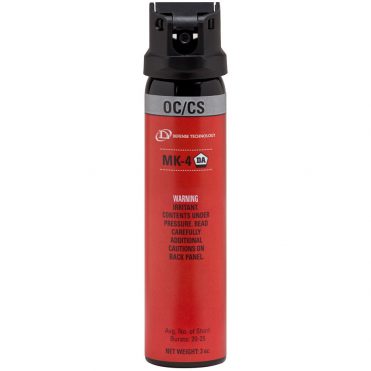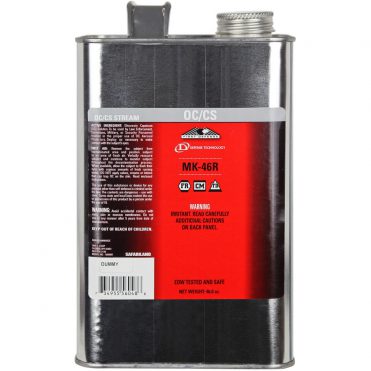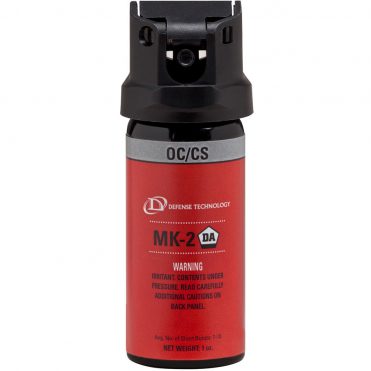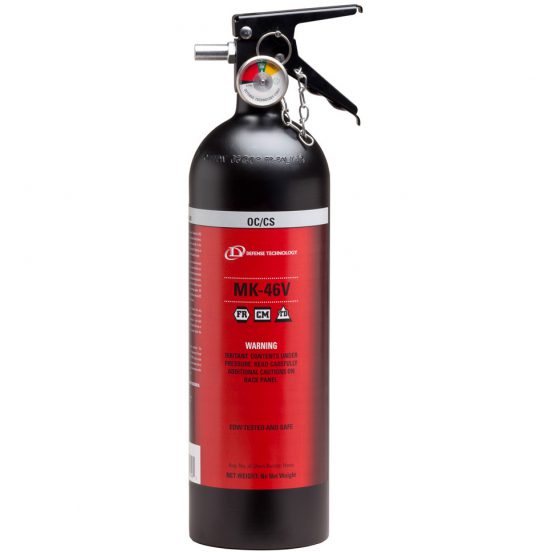
First Defense® OC/CS MK-46V Stream Aerosol
The MK-46 features a trigger handle, is intended for use in crowd management and will deliver 26 short bursts of OC at an effective range of 25-30 ft. This OC/CS aerosol product utilizes a stream delivery method providing a target-specific, strong concentrated stream for greater standoff.
NOT Electronic Discharge Weapon (EDW) safe
Non-flammable
- The stream delivery method provides a target-specific, strong concentrated stream for greater standoff.
- The grey banded canister indicates the unique OC/CS formulation which targets the respiratory system.
- The MK-46 features a trigger handle and is intended for use in crowd management.
- This formulation has been tested and is non-flammable, but is NOT Electronic Discharge Weapon (EDW) safe.
- Defense Technology® First Defense® OC Aerosols are produced in an ISO rated manufacturing facility.
- All Major Capsaicinoid percentages (MC%) are verified by an Independent Laboratory for quality assurance.
FIRST AID FOR OC/CS
I. GENERAL:
Remove affected person from the contaminated area to an open, upwind position.
Keep subject calm and restrict activity.
Most subjects will be well on their way to total recovery 45 minutes after first aid begins.
II. EYES: Intense burning sensation, temporary inflammation of the tissues around the eyes, causing involuntary closure.
Wash eyes out with large amounts of cool water.
DO NOT allow the subject to rub their eyes or face. If the need arises to use a paper towel, use a blotting motion and discard after one use.
Find out if subject is wearing contact lenses. If so, allow them to remove the lenses or call EMS to remove them. DO NOT attempt to remove unless medically trained to do so. Contacts may become contaminated and may need to be discarded.
Keep eyes open facing wind.
Tearing helps clear the eyes.
III. NOSE: Irritation, burning sensation, nasal discharge.
Breathe normally.
Blow nose to remove discharge and particulates.
IV.SKIN: Burning sensation on affected skin areas. Redness may occur on fair-skinned individuals.
DO NOT apply creams, salves, oils, lotions or burn cream as they will only trap the agent on the skin.
Flush the subject’s skin with large amounts of cool water and expose the subject to fresh air.
Further relief may be gained by showering with cool water using mild soap and shampooing hair. Wash thoroughly, rinsing often to manage any contaminated water on your body.
V. CHEST: Irritation, burning sensation, coughing, the sensation of shortness of breath, tightness in chest, often accompanied by a feeling of panic.
Subject should relax and keep calm.
Talking reassuringly to the subject may help to relieve their discomfort and prevent panic.
NOTE: If at any point the subject states or appears that they are in medical distress, immediately contact the EMS or a Medical Service Unit.
Contact Defense Technology® with any questions regarding these procedures.
AREA DECONTAMINATION FOR OC/CS
STEP 1: Ventilate the building to remove airborne CS. Open all doors and windows that weather permits. The sooner this can be done, the better. If fans can be placed to increase ventilation, this will help. Remove spent chemical agent casings immediately as they are heavily contaminated. Remove all contents for separate decontamination.
STEP 2: If CS powder was used, a commercial water vacuum cleaner should be used to trap the powder. Wet clean where possible, using commercially available detergents like Dawn or Simple Green.
STEP 3: Shut all doors and windows and heat the building as hot as is practical (at least four hours at a minimum of 95° F (35°C). Open a window at each end of the building. Place a fan blowing to the outside at one of the openings. Continue to heat the building. This vaporizes much of the CS and carries it out of the building.
STEP 4: Surfaces which will not be damaged can be decontaminated with a 5% solution of baking soda (sodium bicarbonate).
STEP 5: Dry cleaning is suggested for decontaminating clothing and other fabrics. More than one treatment may be necessary.
STEP 6: Exposed foods will absorb CS and should be discarded. CS penetrates many plastics, so wrapped foods will probably be contaminated. Foods in cans may be usable after the outside of the cans have been thoroughly cleaned. Always check with the local health department regarding the sale of merchandise that has been exposed to chemical agents.
NOTE: Rubber gloves and a gauze face mask should be used by personnel during the clean-up stage to prevent the possibility of residual contamination. In heavily contaminated premises, some of the above steps will need to be repeated a number of times to remove lingering traces of CN or CS.
STORAGE OF OC PEPPER SPRAY CANISTERS
Poor storage conditions will significantly reduce the shelf life of these products resulting in the replacement of the canisters sooner than necessary or the possible use of defective products. Humidity and heat are the two most damaging factors that destroy OC canisters.
The canisters and grenades should be stored in a controlled atmosphere with temperatures between 60 degrees Fahrenheit to 75 degrees Fahrenheit with less than 60% relative humidity.
Canisters should remain sealed in their shipping containers until they are to be used or placed in a duty belt/holster.
Never store canisters in the trunk of a car for prolonged periods. The heat may cause the canisters to build pressure and eventually release propellant and possibly agent or OC.
Stored munitions should be inspected for physical integrity and a representative sample functioned twice a year. Munitions that have surpassed the warranty of 5 YEARS should be replaced.
DISPOSAL OF OC PEPPER SPRAY CANISTERS
The following information is intended only to provide general information for our customers. It is extremely important that anyone using our products comply with all applicable environmental laws and regulations. We recommend that you consult with appropriate legal counsel or governmental authorities prior to disposing of any of our chemical products.
In 1976, Congress enacted a law entitled, The Resource Conservations and Recovery Act of 1976 (RCRA). This law was intended to protect human health and the environment from imprudent disposal of “hazardous wastes.”
Outdated or otherwise unusable pyrotechnic items are considered “hazardous waste” under RCRA and are assigned the EPA hazardous waste code of D00 1 due to their ignitable characteristic. Disposal of these items must be done in accordance with all applicable Federal and/or State laws. Many states have hazardous waste management programs that are much more stringent than Federal law. For this reason, you should check with the EPA Regional Office to determine to what extent these laws apply to you.
What is the difference between SHUs and MC%?
Defense Technology® no longer recognizes Scoville Heat Units (SHUs) as a viable means to measure pungency in regards to pepper spray.
Scoville Heat Units are a subjective measurement system dating back to the American Spice Trade. For years SHUs have been used as a measuring system within the pepper spray industry, resulting in confusion and a lack of confidence and consistency regarding the pungency and percentage of OC formulations.
High Performance Liquid Chromatography or HPLC, is the only true way to measure the heat of a formulation. It is a scientific method and ensures consistency. This is the standard used by Defense Technology®. The finished Defense Technology® OC formulations are tested at an independent laboratory tested for the exact percentage of major capsaicinoids (MC%).
